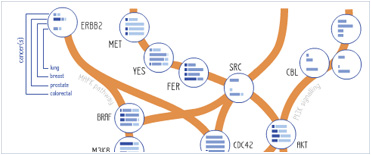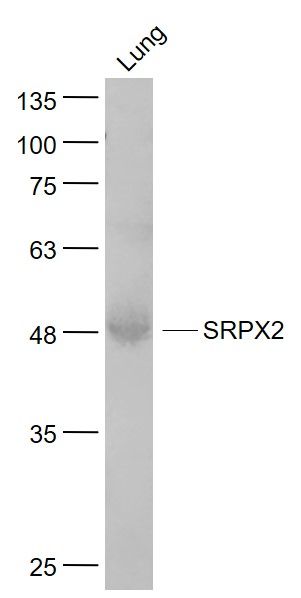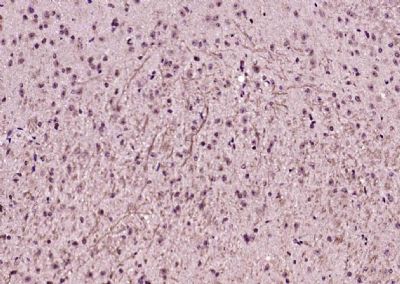SRPX2 Polyclonal Antibody
Purified Rabbit Polyclonal Antibody (Pab)
- SPECIFICATION
- CITATIONS
- PROTOCOLS
- BACKGROUND

Application
| WB, IHC-P, IHC-F, IF, ICC, E |
|---|---|
| Primary Accession | O60687 |
| Reactivity | Rat |
| Host | Rabbit |
| Clonality | Polyclonal |
| Calculated MW | 50 KDa |
| Physical State | Liquid |
| Immunogen | KLH conjugated synthetic peptide derived from human SRPX2 |
| Epitope Specificity | 121-220/465 |
| Isotype | IgG |
| Purity | affinity purified by Protein A |
| Buffer | 0.01M TBS (pH7.4) with 1% BSA, 0.02% Proclin300 and 50% Glycerol. |
| SUBCELLULAR LOCATION | Cytoplasm. Secreted. |
| SIMILARITY | Contains 1 HYR domain. Contains 3 Sushi (CCP/SCR) domains. |
| SUBUNIT | Interacts with ADAMTS4, CTSB and PLAUR. Interacts with PLAUR (via the UPAR/Ly6 domains). |
| DISEASE | Defects in SRPX2 are a cause of bilateral perisylvian polymicrogyria (BPP) [MIM:300388]. BPP is the most common form of polymicrogyria, a malformation of the cortex, in which the brain surface is irregular and the normal gyral pattern replaced by multiple small, partly fused, gyri separated by shallow sulci. BPP results in mild mental retardation, epilepsy and pseudobulbar palsy, causing difficulties with expressive speech and feeding. Defects in SRPX2 are a cause of rolandic epilepsy with speech dyspraxia and mental retardation X-linked (RESDX) [MIM:300643]. A condition characterized by the association of rolandic seizures with oral and speech dyspraxia, and mental retardation. Rolandic occur during a period of significant brain maturation. During this time, dysfunction of neural network activities such as focal discharges may be associated with specific developmental disabilities resulting in specific cognitive impairments of language, visuo-spatial abilities or attention. |
| Important Note | This product as supplied is intended for research use only, not for use in human, therapeutic or diagnostic applications. |
| Background Descriptions | SRPX2 is a 465 amino acid secreted protein expressed in neurons of the brain, including the rolandic area. It has been suggested that SRPX2 enhances cell motility, migration and adhesion through FAK signaling in gastric and other cancer cells. Localized to the cytoplasm, SRPX2 is a ligand for uPAR (urokinase plasminogen activator), a receptor that is a crucial component of the extracellular plasminogen proteolysis system. SRPX2 may be responsible for rolandic seizures (RSs) associated with oral and speech dyspraxia and mental retardation (MR). The involvement of SRPX2 in these disorders suggests an important role for SRPX2 in the perisylvian region critical for language and cognitive development. |
| Gene ID | 27286 |
|---|---|
| Other Names | Sushi repeat-containing protein SRPX2, Sushi-repeat protein upregulated in leukemia, SRPX2, SRPUL |
| Target/Specificity | Expressed in neurons of the rolandic area of the brain (at protein level). Highly expressed in the brain, placenta, lung, trachea, uterus and adrenal gland. Weakly expressed in the peripheral blood, brain and bone marrow. Expressed in numerous cancer cell lines. |
| Dilution | WB=1:500-2000,IHC-P=1:100-500,IHC-F=1:100-500,ICC=1:100-500,IF=1:100-500,ELISA=1:5000-10000 |
| Format | 0.01M TBS(pH7.4), 0.09% (W/V) sodium azide and 50% Glyce |
| Storage | Store at -20 ℃ for one year. Avoid repeated freeze/thaw cycles. When reconstituted in sterile pH 7.4 0.01M PBS or diluent of antibody the antibody is stable for at least two weeks at 2-4 ℃. |
| Name | SRPX2 |
|---|---|
| Synonyms | SRPUL |
| Function | Acts as a ligand for the urokinase plasminogen activator surface receptor. Plays a role in angiogenesis by inducing endothelial cell migration and the formation of vascular network (cords). Involved in cellular migration and adhesion. Increases the phosphorylation levels of FAK. Interacts with and increases the mitogenic activity of HGF. Promotes synapse formation. May have a role in the perisylvian region, critical for language and cognitive development. |
| Cellular Location | Secreted. Cytoplasm. Cell surface. Synapse |
| Tissue Location | Expressed in neurons of the rolandic area of the brain (at protein level). Highly expressed in the brain, placenta, lung, trachea, uterus, adrenal gland, heart, ovary and placenta. Weakly expressed in the peripheral blood, brain and bone marrow. Expressed in numerous cancer cell lines and in gastrointestinal cancer cells. Higher levels found in colorectal cancers than in normal colonic mucosa |

Thousands of laboratories across the world have published research that depended on the performance of antibodies from Abcepta to advance their research. Check out links to articles that cite our products in major peer-reviewed journals, organized by research category.
info@abcepta.com, and receive a free "I Love Antibodies" mug.
Provided below are standard protocols that you may find useful for product applications.
If you have used an Abcepta product and would like to share how it has performed, please click on the "Submit Review" button and provide the requested information. Our staff will examine and post your review and contact you if needed.
If you have any additional inquiries please email technical services at tech@abcepta.com.













 Foundational characteristics of cancer include proliferation, angiogenesis, migration, evasion of apoptosis, and cellular immortality. Find key markers for these cellular processes and antibodies to detect them.
Foundational characteristics of cancer include proliferation, angiogenesis, migration, evasion of apoptosis, and cellular immortality. Find key markers for these cellular processes and antibodies to detect them. The SUMOplot™ Analysis Program predicts and scores sumoylation sites in your protein. SUMOylation is a post-translational modification involved in various cellular processes, such as nuclear-cytosolic transport, transcriptional regulation, apoptosis, protein stability, response to stress, and progression through the cell cycle.
The SUMOplot™ Analysis Program predicts and scores sumoylation sites in your protein. SUMOylation is a post-translational modification involved in various cellular processes, such as nuclear-cytosolic transport, transcriptional regulation, apoptosis, protein stability, response to stress, and progression through the cell cycle. The Autophagy Receptor Motif Plotter predicts and scores autophagy receptor binding sites in your protein. Identifying proteins connected to this pathway is critical to understanding the role of autophagy in physiological as well as pathological processes such as development, differentiation, neurodegenerative diseases, stress, infection, and cancer.
The Autophagy Receptor Motif Plotter predicts and scores autophagy receptor binding sites in your protein. Identifying proteins connected to this pathway is critical to understanding the role of autophagy in physiological as well as pathological processes such as development, differentiation, neurodegenerative diseases, stress, infection, and cancer.



